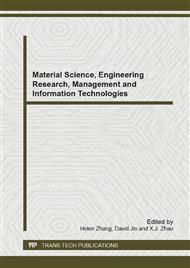[1]
Bradley G. Ridoutt, Stephan Pfister, 2010. A Revised Approach to Water Footprinting to Make Transparent the Impacts of Consumption and Production on Global Freshwater Scarcity[J]. Global Environmental Change, 20(1): 113–120.
DOI: 10.1016/j.gloenvcha.2009.08.003
Google Scholar
[2]
Lucia S. Herbeck, Daniela Unger, Ying Wu, Tim C. Jennerjahn, 2013. Effluent, Nutrient and Organic Matter Export from Shrimp and Fish Ponds Causing Eutrophication in Coastal and Back-reef Waters of NE Hainan, Tropical China. Continental Shelf Research, 57: 92-104.
DOI: 10.1016/j.csr.2012.05.006
Google Scholar
[3]
Wu Bao-cheng, Shen Guo-qiang, Yang Chun-xia, Zhang Dong, 2010. The Application Status and Prospects about the Probiotics Used in Water Purification. Environmental Science & Technology, 33(12F): 408-410. (in Chinese).
Google Scholar
[4]
Bai Xiao-li, Liang Xu-fang, Liang Yun-xiang, Guo Xiao-ze, Li Ling, 2013. Effects of Nitrifying Bacteria on Water Quality of the Mandarin Fish(Siniperca Chuatsi) and Bait Fish Ponds. Guangdong Agricultural Sciences, (2): 107-109. (in Chinese).
Google Scholar
[5]
H. Shan, J.P. Obbard, 2001. Ammonia removal from prawn aquaculture water using immobilized nitrifying bacteria. Appl Microbiol Biotechnol, 57: 791–798.
DOI: 10.1007/s00253-001-0835-1
Google Scholar
[6]
Pai Shwu-ling, Chong Nyuk-min, Chen Chei-hsiang, 1999. Potential Applications of Aerobic Denitrifying Bacteria as Bioagents in Wastewater Treatment. Bioresource Technology, 68(2): 179-185.
DOI: 10.1016/s0960-8524(98)00140-0
Google Scholar
[7]
Meng Rui, He Lian-sheng, Xi Bei-dou, Hu Xiang, Li Yue-yan, 2009. Experimental Study on Purifying Aquaculture Wastewater between Bacillus and Nitrifying Bacteria. Environmental Science & Technology, 32(11): 28-31).
Google Scholar
[8]
Liu Ying-xia, Chang Xian-bo, Yang Qi-xia, 2010. Effect of EM on Water Qualities in Shrimp Ponds. Journal of Anhui Agri Sci, 38 (13): 6891-6892. (in Chinese).
Google Scholar
[9]
Xiao Jing-jing, Zhu Chang-xiong, Sun Dong-yuan, Guo Ping, Tian Yun-long, 2011. Removal of Ammonium-N from Ammonium-rich Sewage using an Immobilized Bacillus subtilis AYC Bioreactor System. Journal of Environmental Sciences, 23(8): 1279-1285.
DOI: 10.1016/s1001-0742(10)60542-6
Google Scholar
[10]
Wang Lin, Huang Li-Jing, Yun Luo-Jia, Tang Fei, Zhao Jing-hui, Liu Yan-qun, Zheng Xing, Luo Qi-fang, 2008. Removal of Nitrogen, Phosphorus, and Organic Pollutants From Water Using Seeding Type Immobilized Microorganisms. Biomedical and Environmental Sciences, 21(2): 150-156.
DOI: 10.1016/s0895-3988(08)60021-5
Google Scholar
[11]
N.J. Manju, V. Deepesh, Cini Achuthan, Philip Rosamma, I.S. Bright Singh, 2009. Immobilization of Nitrifying Bacterial Consortia on Wood Particles for Bioaugmenting Nitrification in Shrimp Culture Systems. Aquaculture, 294(1-2): 65-75.
DOI: 10.1016/j.aquaculture.2009.05.008
Google Scholar
[12]
Soo Kyong Jeong, Jeong-Sup Cho, In-Soo Kong, Hyun Do Jeong, Joong Kyun Kim, 2009. Purification of Aquarium Water by PVA Gel-Immobilized Photosynthetic Bacteria during Goldfish Rearing. Biotechnology and Bioprocess Engineering, 14: 238-247.
DOI: 10.1007/s12257-008-0195-0
Google Scholar
[13]
Leila Chebil Ajjabi, Lassaad Chouba, 2009. Biosorption of Cu2+ and Zn2+ from Aqueous Solutions by Dried Marine Green Macroalga Chaetomorpha linum. Journal of Environmental Management, 90(11): 3485-3489.
DOI: 10.1016/j.jenvman.2009.06.001
Google Scholar
[14]
Maria Mar Areco, Sergio Hanela, Jorge Duran, María dos Santos Afonso, 2012. Biosorption of Cu(II), Zn(II), Cd(II) and Pb(II) by Dead Biomasses of Green Alga Ulva lactuca and the Development of a Sustainable Matrix for Adsorption Implementation. Journal of Hazardous Materials, 213-214: 123-132.
DOI: 10.1016/j.jhazmat.2012.01.073
Google Scholar
[15]
Jin Shu-quan, Zhou Jin-bo, Zhu Xiao-li, Yao Yong-ru, Cai Guo-cheng, Chen Ruo-xia, 2010. Comparison of Nitrogen and Phosphorus Uptake and Water Purification Ability of Ten Aquatic Macrophysics. Journal of Agro-Environment Science, 29(8): 1571-1575. (in Chinese).
Google Scholar
[16]
E. Marinho-Soriano C.A.A. Azevedo, T.G. Trigueiro, D.C. Pereira, M.A.A. Carneiro, M.R. Camara, 2011. Bioremediation of Aquaculture Wastewater using Macroalgae and Artemia. International Biodeterioration & Biodegradation, 65(1): 253-257.
DOI: 10.1016/j.ibiod.2010.10.001
Google Scholar
[17]
MN Hasan, MS Rahman, MF Hosen, MA Bashar, 2012. Effects of Addition of Tilapia on the Abundance of Periphyton in Freshwater Prawn Culture Ponds with Periphyton Substrates. Journal of the Bangladesh Agricultural University, 10(2): 313-324.
DOI: 10.3329/jbau.v10i2.14924
Google Scholar
[18]
Le Van Khoi, Ravi Fotedar, 2012. Integration of Blue Mussel (Mytilus edulis Linnaeus, 1758) with Western King Prawn (Penaeus latisulcatus Kishinouye, 1896) in a Closed Recirculating Aquaculture System under Laboratory Conditions. Aquaculture, 354-355: 84-90.
DOI: 10.1016/j.aquaculture.2012.03.036
Google Scholar
[19]
Nathalie Korboulewsky, Runying Wang, Virginie Baldy, 2012. Purification Processes Involved in Sludge Treatment by a Vertical Flow Wetland System: Focus on the Role of the Substrate and Plants on N and P Removal. Bioresource Technology, 105: 9-14.
DOI: 10.1016/j.biortech.2011.11.037
Google Scholar
[20]
Lin Ying-feng, Jing Shuh-ren, Lee Der-yuan, Chang Yih-feng, Sui, Hsuan-yu, 2010. Constructed Wetlands for Water Pollution Management of Aquaculture Farms Conducting Earthen Pond Culture. Water Environment Research, 82(8): 759-768.
DOI: 10.2175/106143010x12609736966685
Google Scholar
[21]
Fei Zhong, Wei Liang, Tao Yu, Shui P. Cheng, Feng He, Zhen B. Wu, 2011. Removal Efficiency and Balance of Nitrogen in a Recirculating Aquaculture System Integrated with Constructed Wetlands. Journal of Environmental Science and Health, Part A: Toxic/Hazardous Substances and Environmental Engineering, 46(7): 789-794.
DOI: 10.1080/10934529.2011.571974
Google Scholar
[22]
Chih-Ju Jou, Shyh-Wei Chen, Kuo-Hung Tseng, C. M. Kao, 2009. Efficiency and Ecological Benefits of Purifying Wu-Lo Creek with a Constructed Wetland System. Environmental Engineering Science, 26(1): 97-102.
DOI: 10.1089/ees.2007.0216
Google Scholar


